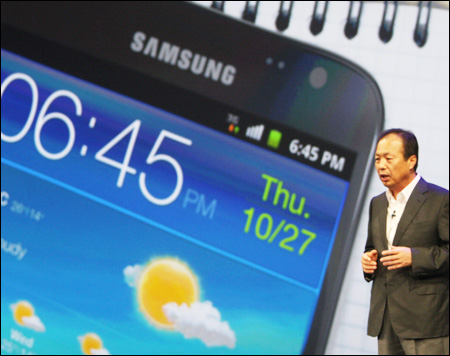
Plenty of bang for buck

Samsung Electronics chalks up record profits on mobile sales
Samsung Electronics posted its best quarterly operating profit during the first three months of this year and is expected to improve on it during the seasonally-favorable second quarter.
The world’s biggest supplier of flat screens, memory chips and smartphones reported 45.27 trillion won Friday in first-quarter revenue, up 22 percent from a year ago.
Operating profit was 5.85 trillion won, up 98 percent year-on-year. The firm said its impressive performance is thanks to solid sales of finished goods such as smartphones and LED-backlit LCD televisions.
“Samsung sold more smartphones than we expected. The company will release more low- and high-end smartphones in the second quarter to meet rising demand for our phones,’’ Samsung spokesman Lee Seung-joon said.
Its information technology and mobile communications division, which handles smartphone business, contributed much to the feat as it racked up 4.27 trillion won in operating profit, while its revenue was 23.22 trillion won.
Samsung sold over 4 million of its Galaxy Note in the first quarter.
It declined to unveil how many smartphones that the technology giant sold during the January-March period but analysts say it ended Nokia’s 14-year leadership of the global phone market, outselling the struggling Finnish company for the first time.
Nokia sold 83 million handsets during the first quarter, including 12 million smartphones. The Korean outfit sold 91 million, including 46 million smartphones, Samsung officials told The Korea Times, asking not to be identified.
In a conference call to analysts and investors, Samsung said it is planning to introduce more budget smartphones and is confident on the outlook for its upcoming Galaxy S III.
“The Galaxy S III will become the most successful smartphone in Samsung’s phone-making history,’’ said Robert Yi, chief of Samsung’s investor relations team.
Samsung will announce another Galaxy sequel at its “Mobile Unpack” event in London on May 3. Yi said the commercial launch of the new handset will be in the second quarter.
It is thought rival Apple will also release its upgraded iPhone ― tentatively named the iPhone 5_ sometime in the second quarter. It is also preparing to launch a mini iPad, possibly called the iPad Mini.
As The Korea Times exclusively reported, the Galaxy S III will use Samsung’s quad-core mobile application processor (AP) but with differentiations according to the market. Samsung is going to use Qualcomm chips for the U.S. version, while those for Europe and South Korea will use the firm’s Exynos quad-core mobile AP.
Samsung and Apple have formed a new duopoly in high-end smartphones globally, as competitors struggle to release competitive models.
Between the two they controlled 90 percent of the high-end segment last year and their combined stake will remain little changed at 88 percent by 2013, according to Bernstein analysts.
Samsung’s television business saw a turnaround in quarterly profit, reporting some 500 billion won after setbacks in previous quarters, according to company officials. Samsung is also the world’s top maker of flat-screen televisions.
Brighter future in chips, flat screens
Profits from Samsung’s chip business more than halved to 760 billion won, hit by weaker computer memory chip prices. But Yi told analysts and investors that profits from its chip business will soar in the second quarter.
“Samsung’s chip-making division will report bigger profits in the second quarter from the first as huge sales of smartphones and tablets are lifting the demand for NAND flash memory chips,’’ Yi said.
NAND flash and DRAM chips are categorized as memory chips. They can read, write and store data. NAND flashes are vital for data-intensive products.
Samsung supplies its DRAMs and NANDs to top-tier tech firms including Apple and Hewlett-Packard as it is the sole maker that can guarantee better pricing, output commitment and on-time delivery.
Memory chips are volatile and cyclical according to market situations as consumers cut back their spending on chip-embedded products when economies struggle. Elpida of Japan filed for bankruptcy protection in February and the world’s No. 2 chipmaker SK hynix suffered from a drop in profit in the first quarter.
“Samsung will invest more in chips during the first half. We are planning to increase the output of mobile APs using a finer 32-nanometer processing technology within the second quarter to meet rising demand from consumers who want much faster data processing and downloading,’’ said Yi.
Samsung will maintain this year’s investment budget of 25 trillion won for facilities, he added.
Consumer electronics companies typically see their quarterly earnings peak in the second or third quarter as manufacturers produce more goods ahead of the back-to-school season in North America and Europe and the year-end big shopping season.
“Samsung’s business momentum is still looking good as its dual-strengths ― parts and finished goods ― are helping it boost earnings, steadily, amid the recovery of consumer spending,’’ said Seo Wok-suk, an analyst at Korea Investment, Friday.
“Samsung will report over 7 trillion won in operating profit and 50 trillion won in revenue in the second quarter,’’ said Kim Sung-in, a senior analyst at Kium Securities.
In a separate statement, Samsung Display announced that it will acquire Samsung Mobile Display (SMD) and S-LCD to create a single entity to see an “economies of a scale’’ for its flat-screen business.
“Samsung will heavily invest in OLED screens and the acquisition marks its first step for the goal,’’ said a high-ranking Samsung executive, requesting anonymity. <KoreaTimes/Kim Yoo-chul>


